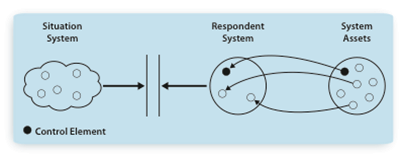Difference between revisions of "System Coupling Diagram (glossary)"
Wikiexpert (talk | contribs) m (Removed protection from "system coupling diagram ") |
Wikiexpert (talk | contribs) |
||
| Line 18: | Line 18: | ||
[[Category:Glossary of Terms]] | [[Category:Glossary of Terms]] | ||
| + | {{DISQUS}} | ||
Revision as of 18:35, 23 May 2012
This is a paradigm that conveys the essence of what systems are used for and how systems relate to each other. as portrayed in Figure 1 (Lawson 2010)
Figure 1: System Coupling Diagram
• Situation System – A problem or opportunity situation; either unplanned or planned. The situation may be the work of nature, be man-made, a combination of both or a postulated situation (Thematic System) that is to be used as a basis for deeper understanding and training (for example, business games or military exercises). Thus, the situation may be catastrophe, terrorist action, the capabilities needed for a new system, the next stage in a life cycle of a system. In all cases, in order to affect the situation a response is required.
• Respondent System – The system created to respond to the situation where the parallel bars indicate that this system interacts with the situation and transforms the situation to a new situation. A Respondent System, based upon the situation that is being treated can have several names such as Project, Program, Mission, Task Force, or in a scientific context, Experiment. Note that one of the system elements of this system is a control element that directs the operation of the respondent system in its interaction with the situation. This element is based upon an instantiation of a Control System asset, for example a Command and Control System, or a control process of some form.
• System Assets – The sustained assets of an enterprise that are to be utilized in responding to situations. System assets must be adequately life cycle managed so that when instantiated in a Respondent System will perform their function. These are the systems that are the primary objects of an Enterprise and include their value added products or services as well as their infrastructure systems. Examples of assets include concrete systems such as produced products and/or services, facilities, instruments and tools as well as abstract systems such as theories, knowledge, processes and methods.
Source(s)
Lawson, H. 2010. A Journey Through the Systems Landscape, UK: College Publications, Kings College.
Discussion
The System Coupling Diagram
SEBoK Discussion
Please provide your comments and feedback on the SEBoK below. You will need to log in to DISQUS using an existing account (e.g. Yahoo, Google, Facebook, Twitter, etc.) or create a DISQUS account. Simply type your comment in the text field below and DISQUS will guide you through the login or registration steps. Feedback will be archived and used for future updates to the SEBoK. If you provided a comment that is no longer listed, that comment has been adjudicated. You can view adjudication for comments submitted prior to SEBoK v. 1.0 at SEBoK Review and Adjudication. Later comments are addressed and changes are summarized in the Letter from the Editor and Acknowledgements and Release History.
If you would like to provide edits on this article, recommend new content, or make comments on the SEBoK as a whole, please see the SEBoK Sandbox.
blog comments powered by Disqus